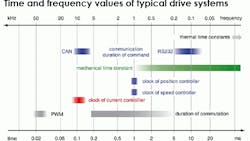Position control primer
The controllers that drive modern motor-powered designs must be set up with accurate motion profiles — including position, velocity, and time targets. However, developing a realistic motion profile requires more than just general knowledge of the mechanical and electrical variables associated with motion control: It is critical to quantify and model each variable, and design around an application's specific limitations — because the time required to execute a move is also determined by the target acceleration, motor capability, and system inertia. In fact, identifying component limitations at the earliest design stages is key to producing a dynamic and efficient system.
Mechanical time constants
First and foremost, designers must consider the mechanical time constant of the motor to be used. The duration of the other variables, as they relate to the mechanical time constant, are illustrated in the graph shown here, which quantifies some typical time and frequency values found in common drive systems.
All dc motors require a certain acceleration period to reach full speed. When this occurs at a constant motor voltage, it follows an exponential curve that can be characterized by the motor's published mechanical time constant. This curve is typically calculated at no-load speed and at the motor's rated voltage. Mechanical time constants vary from one motor manufacturer to another, and can be found in their motor specifications. Typical time constants can range from 2 to 50 msec, depending on the motor model and size selected. Small-diameter motors with neodymium magnets, for example, accelerate more quickly.
No matter the motor design, making moves in less than a few milliseconds is generally not feasible, especially when load inertia is taken into consideration. Even the most dynamic drives require several milliseconds to react.
Clock frequencies
To efficiently control drive speed or position, it is generally recommended that designers generate a set value (position command) for every millisecond of a design's motion profile, and then compare those with the current values. (It is no coincidence that digital position controls and speed control circuits are typically designed for this level of accuracy, and clocked at 1 kHz.) That said, to extract the most dynamic reaction from the motor possible, the torque required to correct position or speed must be reached as quickly as possible. Therefore, some current controllers can be clocked approximately 10 times faster, at 10 kHz.
Current reaction time — after voltage is applied to the motor — is known as the electrical time constant. This constant can be calculated using the inductance (L) at the terminal and the resistance (R) at the terminal — which in ironless-core motors is relatively small, thanks to the low inductance values. In fact, for the smallest ironless-core motors, values are typically less than 50 µsec, and only reach about 150 µsec on medium-sized motors. This means that current reaches its maximum value very quickly, up to 100 times faster than the motor can react mechanically.
Matching the electrical time constant with a coordinated, high clock frequency from the current controller results in a highly dynamic response.
Current ripple
Pulse width modulation (PWM) frequency is another important consideration. PWM values must be selected so that current is not subjected to excessive ripple within the PWM cycle. Why? Current ripple is a primary cause of unwanted heat at the motor windings and has an adverse effect on current controller stability, and therefore the motion system itself.
One method of addressing a low-inductance condition is to add inductors (motor chokes) that attenuate the current reaction. Motor chokes may be integrated within controllers as well.
Compared to the PWM clock time and the electrical time constant, the commutation period — the duration of a constant terminal connection of the winding — is rather long. Consider these examples: For brushed dc motors with nine commutator segments at 6,000 rpm, the commutation interval is approximately 0.5 msec. Yet, for a high-speed brushless motor at 25,000 rpm and block commutation, it is relatively short at 0.4 msec. To address current transients in low-inductance motors with block commutation, PWM switching in excess of 40 kHz is desirable.
Thermal time constants
Thermal time constants help to characterize the variation of the exponential curves that describe how the motor heats over time. However, when considering thermal time constants, a distinction must be made between the time constant of the winding and the time constant of the stator.
For example, consider a motor product line for which the time constant of the winding is shorter than one second for the smallest motor, and up to one minute for the largest. This number specifies the natural time scale of how long the motor may be subjected to a short-term overload current. A few seconds may elapse prior to the winding reaching its maximum temperature. In contrast, stator time constants describe the heating of the motor as a whole — and take several minutes.
Typically, four or five time constants must pass before the motor reaches its final temperature. Because of this factor, most motors take up to one hour before they reach thermal equilibrium.
Communication delays
Communication between feedback devices and the controller primarily depends on the transmission rate of the selected link, and also includes response times. A speedy fieldbus connection, such as CAN, offers transmission rates up to 1 mbit/sec and can transmit individual commands in slightly longer than 0.2 msec. In just one millisecond, this allows information exchanges and synchronization between several nodes. In contrast, a link using a serial RS232 interface is much slower and the information is not transmitted in real-time — so it may take several milliseconds for a command to be received. However, for most applications, RS232 communication speed is sufficient to coordinate several axes independent of one another.
This month's handy tips courtesy of maxon precision motors inc. For more information, contact (508) 677-0520 or visit maxonmotorusa.com.
